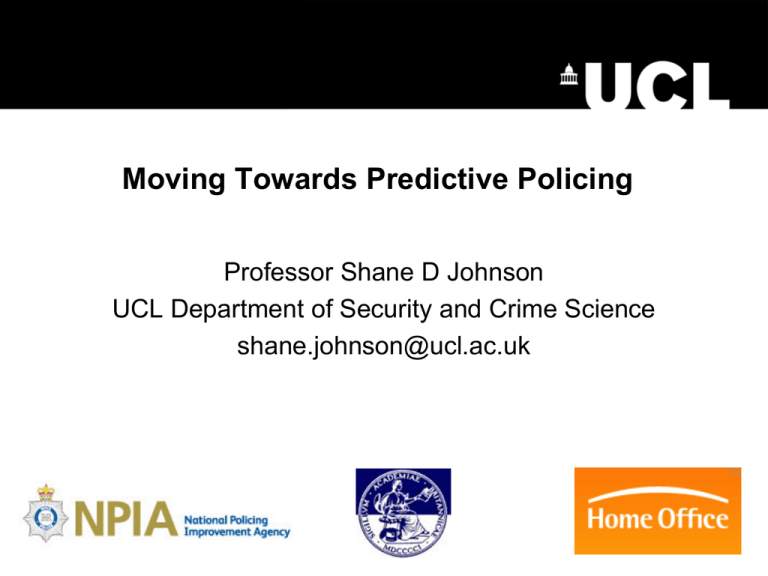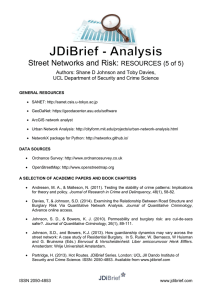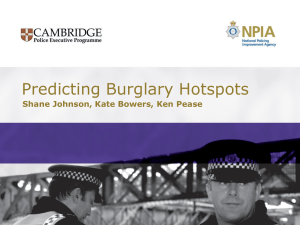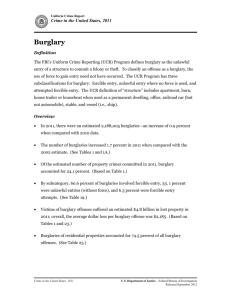
Moving Towards Predictive Policing
Professor Shane D Johnson
UCL Department of Security and Crime Science
shane.johnson@ucl.ac.uk
Predicting future patterns
• Questions we might ask
– How many burglaries are expected in the next few days?
– Bursty analysis (Johnson et al., 2012)?
– Self-exciting Point Process?
– What is likely to be stolen (Bowers & Johnson, 2012)?
– Where will burglaries most likely next occur?
– What is the relative risk within an area for (say) the next
seven days
– By day/night
Overview
• Spatial patterns (risk heterogeneity)
– Patterns and predictors at the street segment level
• Space-time clustering (event dependency)
– What happens in the wake of an offense?
– Point level analysis
• Collaboration with West Midlands Police
– Combining the approaches to analysis
• Displacement?
First things first: Spatial clustering of Burglary?
Ordnance Survey © Crown Copyright. All Rights reserved
Johnson, S.D., and Bowers, K.J. (2010). Permeability and Crime Risk: Are Cul-de-sacs Safer? Journal
of Quantitative Criminology, 26, 113-138.
Spatial Clustering at the Street Level?
Highest risk segments:
5% of homes
40% of burglary
Johnson, S.D. (2010). A Brief History of the Analysis of Crime Concentration. European Journal of
Applied Mathematics, 21, 349-370.
Crime Pattern Theory
• Offender search patterns and personal activity space
• Home to work to recreation – nodes and paths, and mental maps
• Looking for opportunities
• Paths people take and the nodes they inhabit explain their risks to victimisation
Hypotheses
H1 – the risk of burglary will be greater on Major roads and
those intended to be most frequently used
H2 – the risk of burglary will be highest on the most
connected streets, particularly those connected to major
roads
H3 - the risk of burglary will be lower in cul-de-sacs and, in
particular, in those that are non-linear
Johnson, S.D., and Bowers, K.J. (2010). Permeability and Crime Risk: Are Cul-de-sacs Safer? Journal
of Quantitative Criminology, 26, 113-138.
Road classification
• OS classification
–
–
–
–
Major
Minor
Local
Private
• Manual classification (~11k street segments)
– Linear
– Non-linear cul-de-sacs (Sinuous)
Cul-de-Sacs
Mostly Linear
Mostly Sinuous
Ordnance Survey © Crown Copyright. All Rights reserved
Aggregate Results by Segment Type
Concentration at places: Repeat Victimization
Is Victimization Risk Time-Stable?
Timing of repeat victimization
Johnson, S.D., Bowers, K.J., & Hirschfield (1997). New Insights into the Spatial and Temporal Distribution of
Repeat Victimization. British Journal of Criminology, 37(2), 224-241.
Explaining Repeat Victimisation
Boost Account
•
Repeat victimisation is the work of a returning offender
•
Optimal foraging Theory (Johnson & Bowers, 2004) - maximising benefit,
minimising risk and keeping search time to a minimum– repeat victimisation as an example of this
– burglaries on the same street in short spaces of time would also be an
example of this
•
Consider what happens in the wake of a burglary
– To what extent is risk to non-victimised homes shaped by an initial event?
Neighbour effects at the street level
Bowers, K.J., and Johnson, S.D. (2005). Domestic burglary repeats and space-time clusters: the dimensions
of risk. European Journal of Criminology, 2(1), 67-92.
An analogy with disease Communicability
• Communicability - inferred from closeness in space and time of
manifestations of the disease in different people.
++ +
++
+
++ +
+ +++ +
+
area
+
burglaries
Knox Analyses
Previous analysis does not take account of patterns across streets
The degree to which clustering occurs in Euclidian space can be
measured using:
- Monte Carlo simulation and Knox ratios (Knox, 1964; Johnson et al., 2007)
D is ta n c e b e tw e e n e v e n ts in p a ir
T im e b e tw e e n
e v e n ts in p a ir
0 -1 0 0 m
1 0 1 -2 0 0 m
2 0 1 -3 0 0 m
7 d a ys
421
221
189
14 days
246
209
091
21 days
102
237
144
Johnson, S.D. et al. (2007). Space-time patterns of risk: A cross national assessment of residential burglary
victimization. J Quant Criminol 23: 201-219.
Patterns in detection data?
For pairs of crimes:
– Those that occur within 100m and 14 days of each other, 76% are
cleared to the same offender
– Those that occur within 100m and 112 days or more of each other,
only 2% are cleared to the same offender
Johnson, S.D., Summers, L., Pease, K. (2009). Offender as Forager? A Direct Test of the Boost Account of
Victimization. Journal of Quantitative Criminology, 25,181-200.
Near Repeats – Foraging
What do offenders say?
“If this area I didn’t get caught in, I earned enough money to see me
through the day then I’d go back the following day to the same place. If I
was in, say, that place and it came on top, and by it came on top I mean
I was seen, I was confronted, I didn’t feel right, I’d move areas straight
away …” (P02)
“The police certainly see a pattern, don’t they, so even a week’s a bit
too long. Basically two or three days is ideal, you just smash it and then
move on … find somewhere else and then just repeat it, and then the
next area …” (RC02)
Summers, L., Johnson, S.D., & Rengert, G. (2010) The Use of Maps in Offender Interviewing. In W.
Bernasco (Ed.) Offenders on Offending. Willan.
Forecasting burglary risk
Risk
High
Low
Bowers, K.J., Johnson, S.D., and Pease, K. (2004). Prospective Hotspotting: The Future of Crime mapping?
British Journal of Criminology, 44(5), 641-658.
Computer Simulation
Pitcher, A., & Johnson, S.D. (2011). Exploring Theories of Victimization Using a Mathematical Model of
Burglary. Journal of Research in Crime and Delinquency, 48(1), 83-109.
Forecast Accuracy
Grid (50m X 50m cells)
2
2
2
10
3
n=1
R=1
Celli, j,t = å b Celli, j,t-a + åå b Bufferb,t-a + b HouseDensityi, j + å b Districti, j,n + å b Roadi, j,R
a=1
a=1 b=1
KDE+ (Last 10)
KDE+ (1st 10)
Optimal (Last 10)
0.5
0.4
0.3
0.2
0.1
0.0
Fraction of Burglaries
0.6
Optimal (1st 10)
0.7
One BCU – Night (8pm to 8am)
0
2
4
6
% Cells
8
10
Model parameters may need
updating:
-
Changes in offenders at liberty
-
Changes due to police strategy
-
Other factors
But what’s the point of prediction,
targeted policing will only
displace the problem right?
Summary and Combining the Approaches
• Triangulation across methods
• Burglary more likely at more connected segments
– Analyses ignore patterns over time
• Risk of crime temporarily elevated around victimized homes
(predictable in space-time)
– Topology of the street network ignored
– Units of analysis “cells” not street segments
• West Midlands Police and UCL Dept SCS Collaboration (Toby Davies)
– Does risk diffuse along the street network in predictable ways?
– Is risk more likely to be diffused along certain types of segment?
– Other offence types
– Randomized Controlled Trial












